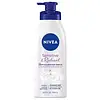What's inside
What's inside
 Key Ingredients
Key Ingredients

 Benefits
Benefits

 Concerns
Concerns

 Ingredients Side-by-side
Ingredients Side-by-side

Water
Skin ConditioningGlycerin
HumectantCetearyl Alcohol
EmollientC15-19 Alkane
SolventGlyceryl Stearate Se
EmulsifyingIsopropyl Palmitate
EmollientGlyceryl Stearate
EmollientPetrolatum
EmollientPanthenol
Skin ConditioningHelianthus Annuus Seed Oil
EmollientPrunus Amygdalus Dulcis Oil
Skin ConditioningGlycine Soja Oil
EmollientHydrolyzed Pearl
Skin ConditioningTocopheryl Acetate
AntioxidantHydrogenated Coco-Glycerides
EmollientSodium Cetearyl Sulfate
CleansingPhenoxyethanol
PreservativeEthylhexylglycerin
Skin ConditioningPantolactone
HumectantCarbomer
Emulsion StabilisingSodium Hydroxide
BufferingCitric Acid
BufferingSodium Citrate
BufferingWater, Glycerin, Cetearyl Alcohol, C15-19 Alkane, Glyceryl Stearate Se, Isopropyl Palmitate, Glyceryl Stearate, Petrolatum, Panthenol, Helianthus Annuus Seed Oil, Prunus Amygdalus Dulcis Oil, Glycine Soja Oil, Hydrolyzed Pearl, Tocopheryl Acetate, Hydrogenated Coco-Glycerides, Sodium Cetearyl Sulfate, Phenoxyethanol, Ethylhexylglycerin, Pantolactone, Carbomer, Sodium Hydroxide, Citric Acid, Sodium Citrate
Water
Skin ConditioningAlcohol Denat.
AntimicrobialIsopropyl Palmitate
EmollientEthylhexyl Salicylate
UV AbsorberBis-Ethylhexyloxyphenol Methoxyphenyl Triazine
Skin ConditioningButyl Methoxydibenzoylmethane
UV AbsorberDibutyl Adipate
EmollientButylene Glycol Dicaprylate/Dicaprate
EmollientEthylhexyl Triazone
UV AbsorberGlyceryl Stearate
EmollientGlycerin
HumectantPhenylbenzimidazole Sulfonic Acid
UV AbsorberSimmondsia Chinensis Seed Oil
EmollientAloe Barbadensis Leaf Juice Powder
Skin ConditioningTocopheryl Acetate
AntioxidantHydroxypropyl Starch Phosphate
Microcrystalline Cellulose
AbsorbentCopernicia Cerifera Cera
EmollientHydrogenated Rapeseed Oil
EmollientSilica Dimethyl Silylate
EmollientCetyl Palmitate
EmollientXanthan Gum
EmulsifyingHydroxyacetophenone
AntioxidantSodium Stearoyl Glutamate
CleansingEthylhexylglycerin
Skin ConditioningTrisodium EDTA
Cellulose Gum
Emulsion StabilisingCaprylyl Glycol
EmollientSodium Hydroxide
BufferingSodium Chloride
MaskingWater, Alcohol Denat., Isopropyl Palmitate, Ethylhexyl Salicylate, Bis-Ethylhexyloxyphenol Methoxyphenyl Triazine, Butyl Methoxydibenzoylmethane, Dibutyl Adipate, Butylene Glycol Dicaprylate/Dicaprate, Ethylhexyl Triazone, Glyceryl Stearate, Glycerin, Phenylbenzimidazole Sulfonic Acid, Simmondsia Chinensis Seed Oil, Aloe Barbadensis Leaf Juice Powder, Tocopheryl Acetate, Hydroxypropyl Starch Phosphate, Microcrystalline Cellulose, Copernicia Cerifera Cera, Hydrogenated Rapeseed Oil, Silica Dimethyl Silylate, Cetyl Palmitate, Xanthan Gum, Hydroxyacetophenone, Sodium Stearoyl Glutamate, Ethylhexylglycerin, Trisodium EDTA, Cellulose Gum, Caprylyl Glycol, Sodium Hydroxide, Sodium Chloride
 Reviews
Reviews

Ingredients Explained
These ingredients are found in both products.
Ingredients higher up in an ingredient list are typically present in a larger amount.
Ethylhexylglycerin (we can't pronounce this either) is commonly used as a preservative and skin softener. It is derived from glyceryl.
You might see Ethylhexylglycerin often paired with other preservatives such as phenoxyethanol. Ethylhexylglycerin has been found to increase the effectiveness of these other preservatives.
Glycerin is already naturally found in your skin. It helps moisturize and protect your skin.
A study from 2016 found glycerin to be more effective as a humectant than AHAs and hyaluronic acid.
As a humectant, it helps the skin stay hydrated by pulling moisture to your skin. The low molecular weight of glycerin allows it to pull moisture into the deeper layers of your skin.
Hydrated skin improves your skin barrier; Your skin barrier helps protect against irritants and bacteria.
Glycerin has also been found to have antimicrobial and antiviral properties. Due to these properties, glycerin is often used in wound and burn treatments.
In cosmetics, glycerin is usually derived from plants such as soybean or palm. However, it can also be sourced from animals, such as tallow or animal fat.
This ingredient is organic, colorless, odorless, and non-toxic.
Glycerin is the name for this ingredient in American English. British English uses Glycerol/Glycerine.
Learn more about GlycerinGlyceryl Stearate is a mix of glycerin and stearic acid.
It is used to stabilize the mixing of water and oil ingredients. By preventing these ingredients from separating, it can help elongate shelf life. It can also help thicken the product's texture.
As an emollient, it helps soften skin and supports barrier-replenishing ingredients.
In cosmetics, Glyceryl Stearate is often made from vegetable oils or synthetically produced.
This ingredient may not be fungal-acne safe
Fun fact: The human body also creates Glyceryl Stearate naturally.
Learn more about Glyceryl StearateIsopropyl Palmitate is a texture enhancer and emollient. It is an ester of isopropyl alcohol and palmitic acid.
Palmitates are emollients. Emollients help keep your skin soft and smooth by creating a barrier that traps moisture in.
When added to cosmetics, Isopropyl Palmitate creates a silky texture and improves spreadability.
Isopropyl Palmitate may not be fungal acne safe. It can worsen acne prone skin.
Learn more about Isopropyl PalmitateSodium Hydroxide is also known as lye or caustic soda. It is used to adjust the pH of products; many ingredients require a specific pH to be effective.
In small amounts, sodium hydroxide is considered safe to use. However, large amounts may cause chemical burns due to its high alkaline.
Your skin has a natural pH and acid mantle. This acid mantle helps prevent harmful bacteria from breaking through. The acid mantle also helps keep your skin hydrated.
"Alkaline" refers to a high pH level. A low pH level would be considered acidic.
Learn more about Sodium HydroxideTocopheryl Acetate is AKA Vitamin E. It is an antioxidant and protects your skin from free radicals. Free radicals damage the skin by breaking down collagen.
One study found using Tocopheryl Acetate with Vitamin C decreased the number of sunburned cells.
Tocopheryl Acetate is commonly found in both skincare and dietary supplements.
Learn more about Tocopheryl AcetateWater. It's the most common cosmetic ingredient of all. You'll usually see it at the top of ingredient lists, meaning that it makes up the largest part of the product.
So why is it so popular? Water most often acts as a solvent - this means that it helps dissolve other ingredients into the formulation.
You'll also recognize water as that liquid we all need to stay alive. If you see this, drink a glass of water. Stay hydrated!
Learn more about Water